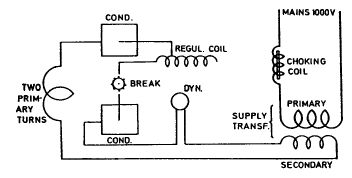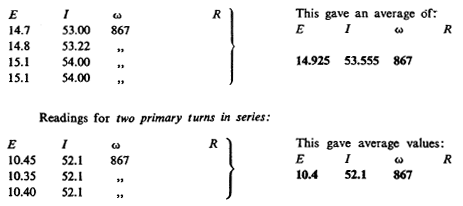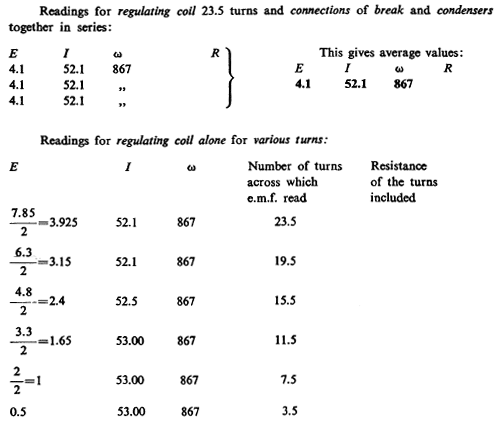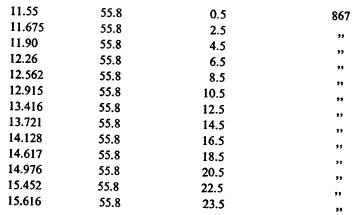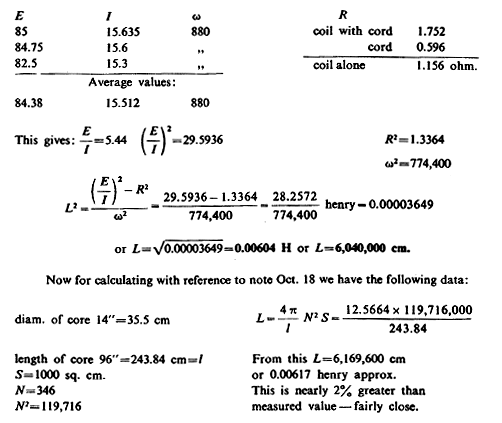|
This is closely agreeing with first measurement of a few days ago,
the difference being only 1/10%.
The ball was shellaced several times and finally covered with weatherproof rubber paint. The pole all along was also painted with the same paint. On the lowest end of 7" pipe a cap was screwed clearing the wood so as to make it more difficult for the streamers to get to the ground along the pole.
* To prevent lateral play 8 champagne bottles set in beams were used.
The coil is to be wound with cord No. 20, before used in the coil of
404 turns on 25.25" diam. drum.
For the purposes contemplated this coil will be well adapted as the
self-induction is large and owing to small diameter of the core and
great thickness of insulation the capacity should be comparatively
small. With this coil balls of 18" and 30" diam, are to be used:
Outside diam. of core=10 3/8"=10.375"=26.3525 cm. Turns 550, No. 18 B. & S. wax covered, thickness of one insul 14"/1000, length of core l =407/8"=40.875"=103.8225 cm.
This coil is now to be also used in investigations of the variation of capacity with. variation of Height. With ball of 18" diam., the capacity of the ball assuming to be: [18"= = 18x2.54=45.72 cm]—C=22.86 cm, the period of the system, neglecting for the present the distributed capacity of the coil, would be approximately:
or n = 223,540 per sec. approx.
In a test resonance was obtained with 42 bottles on each side of the break, that lis 21 bottles total or 0.0229 mfd capacity in the primary, which consisted of 6 turns of heavily covered wire No. 10. As it was inconvenient to measure the primary, Lp was estimated to have a self-induction of:
This is a convenient and good method
but the period must be exactly ascertained. The distributed capacity
can never be neglected.
For future reference the tanks as used are indicated in diagram. The total capacity in primary was therefore 118/2=59 bottles. Since one tank, that is 36bottles, equals 0.03816 mfd the capacity was 59/36 x 0.03816 = 0.06254 mfd.
This would suppose that the ball could have a capacity of 38.1 cm but this is physically impossible since it would have to be removed from all objects.
In reality its capacity will be always much greater and the system will vibrate much slower as a rule. In fact, the test showed that resonance was attained with the ball 10—18 feet from the ground with all bottles in and in addition 5 1 /2 turns in the self-induction box.
The
tuning was naturally not sharp as the capacity was large and the
maximum appeared to be with the ball 10—18 feet from the ground. To
get sharper tuning a smaller ball of 18" diameter was used and now
resonance was obtained with the ball 10 feet from the ground and all
bottles in and no self-induction in the regulating coil.
One end of the coil was connected to that end of condensers, or respectively to that end or terminal of transformer which was grounded and the rise of potential of free terminal of tuned coil was observed by an adjustable spark gap. In this manner very close adjustments are easy.
The resonating condition indicated by the longest sparks in the adjustable gap was secured with the following three values:
Now L1 and L2 should be exactly measured; resonance method will probably suit the purpose best. This is to be more rigorously carried out. In the experiments before described, for the purpose of ascertaining the influence of elevation on the capacity of a sphere, the latter was connected to the coil of 404 turns by means of a wire No. 10 heavily covered with rubber (3/8" wall).
Evidently this wire affected the period of the system and to ascertain to what extent, the wire was placed in the same position as when used in the experiments with the ball at its lowest position — 20.66 feet from the ground. The sphere was omitted but the streamers on .the end were prevented by sealing the end with wax, covering with tape and sticking the end of the wire into a glass bottle with very heavy walls.
Resonance was attained with (6 x 36)—2 bottles on each side and 21 turns in the self-induction regulating coil. This was 214 bottles on each side or 107 total. In making the test the primary turn of the oscillator, usually connecting the two coatings of the condensers on the bottom, was left off and the coatings joined by a short wire. The total self-induction in the primary circuit was therefore the 21 turns of the regulating coil plus the connections, or from previous figures 100,800+ +6600=107,400 cm.
Now in the test of Oct. 9, with the ball connected to the cable, resonance was obtained with 4.66 tanks on each side or 4.66x36=168 bottles approx. The total self-induction was 21.5 turns of regulating coil+1 turn primary + connections= 103,200+56,400+6600=166,200 cm, both values from calculated data.
Had the self induction been the same we would have had instead of 168 bottles 166,200/107,400=260 bottles. 107,400 Thus with the sphere the capacity in the vibrating secondary system was increased by 260 130 the ratio or 260/214 or 130/107.
This was the capacity with the cable comprised. But before we have found the capacity of the coil alone, with no wire attached, 90 cm or nearly so.
The addition of the rubber cable made therefore a considerable difference. It would not have been so high had the streamers been entirely prevented but despite the wax and glass bottle there was a leak which had the tame effect as if the capacity had been increased. Since by adding the ball the capacity
The results of the tests are given in the table below:
The spark was getting longer because the efficiency of the exciting
circuit was increased, as the inductance of this circuit was
increased and capacity diminished. There were smaller frictional
losses and after each break the system vibrated longer and excited
the coil better.
In order to get useful data as to the self-induction of the connections and also of the various turns of the regulating coil which were most frequently used in the experiments, tests were made as follows. A coil still to be described, built for a special purpose, was used (689 turns, drum 14" diam., 8 feet long) and was excited from one terminal of the condensers, as indicated in the sketch below.
The coil had a definite period which was ascertained with all condensers in and the least possible self-induction; the condensers were taken out and more turns of the self-induction coil inserted until resonance was again attained. Since the period was in all instances the same the self-inductance of the circuit was thus varied inversely as the capacity.
When all self-inductance or nearly
so was taken out and only the connections remained by a simple ratio
between the known capacities and a known inductance, the inductance
of the connections was given, or else this quantity was ascertained
from the known period which was maintained throughout the
experiments (that of the coil before referred to). The lower ends of
the condensers, usually joined by the primary, were connected by a
short stout conductor of inappreciable resistance and inductance.
The coil used in the experiments was one of very high self-induction to make the tuning very sharp and it was wound on a drum of relatively small diameter to reduce internal distributed capacity. This likewise improves the sharpness of the adjustment. It was easy to detect variations of one sixteenth of one turn of the regulating primary coil.
From the preceding data, calling / the inductance of one turn and /, that of 22 turns, and C the capacity in the primary when 1.125 turns were used and Q that when 22 turns were employed, we have, since the period was the same:
From this the inductance of the connections would be=8040 cm,
or-8000 cm. approx. It would be desirable, however, to eliminate the
turns of the coil and so estimate the inductance of the connections
directly.
This framework supported, on a projecting crossbeam, a pulley (wood) with cord for pulling up a ball or other object to any desired height within the limits permitted and this beam also carried on its extreme end and-close to the pulley a strong glass bottle within which was fastened a bare wire No. 10, which extented vertically downward to the top of the coil.
The bottle was an ordinary Champagne bottle, from which the
wine had been poured out! and the bottom broken in. It was forced
neck downward into a hole bored into the beam and fastened besides
with a cord. A tapering plug of hard wood was wedged into the neck
and into this plug was fastened the wire. The bottle was finally
filled with melted wax.
This is a necessary precaution to avoid possible losses by streamers when the sphere is charged to a high potential. It is desirable to work with strong effects as the greater these are the better the vibration can be determined, but it is necessary to carefully avoid losses and errors owing to the formation of streamers.
These have the effect of increasing the apparent capacity so much that a thin wire may often produce results comparable to those obtained with large capacities. The streamers, of course, cause frictional loss and thereby diminish the economy of the system and impair the quality of the results. They also cause a loss of pressure just as leaks in air on water pipes.
The ball to be tested or any other object was provided with two metallic bushings, on contacts c c, consisting of small split brass tubings which were in good connection with the conducting surface and also insured contact with wire w which at the same time served to guide the ball in its up and down movement.
To avoid losses the bushings did not project beyond the surface of the ball and for the same reason the cord was not fastened to a hook but a hole was drilled into the ball, the cord with a knot on the end was slipped in and a wooden plug driven into the hole, so that nothing was sticking out capable of giving off streamers or causing leaks into the air. In the first series of experiments a ball of 18" diameter was used. The ball was not perfectly round but the error due to a slight irregularity of shape was very small.
The plan of connections is shown in the sketch in which the same letters are used to designate the same parts of apparatus as before. The excitation of the coil was effected by connecting the lower end to one of the terminals of the condenser — the one which was connected to that end of the secondary of the 60,000 volt transformer which was in connection with the tank. The tank, as described on a previous occasion, was usually connected to the ground but in these first experiments the ground connection was omitted to secure stronger excitation.
From the terminals of the coil two thin and heavily insulated wires were led to an adjustable spark gap s which was manipulated until the maximum rise of potential on the coil was ascertained. The two sets of condensers were joined by a stout short wire W of inappreciable self-induction and resistance and the inductance of the exciting circuit was varied by inserting more or fewer of the turns of the regulating coil R Into the circuit through which the condensers were periodically discharged.
The wires leading from the coil to the adjustable spark gap s were, as before remarked, very thin, as short as it was practicable to make them and heavily insulated. By observing these precautions the error due to the capacity of these wires themselves was reduced to a minimum, also the loss owing to a possible formation of streamers. To reduce the capacity the wires were led far apart and then brought in line to the spark gap.
The lower wire, which was connected to a point of comparatively low potential was of little consequence but on the top wire these precautions were imperative. The procedure was as follows: first the period of the coil L and capacity attached to the free terminal was ascertained by varying the capacity or self-induction, or both, of the primary or exciting circuit until resonance was reached which was evident from the maximum rise of potential.
When the period had thus been determined with the capacity, say a sphere, in one position, the position of the body of capacity was varied by shifting it to another place along the wire w and the adjustment of the primary circuit was again effected until resonance was reached, generally by simply varying the length of wire of the regulating coil included in the primary circuit. Now as the self-induction of the coil L remained the same through all experiments, the apparent capacity could be easily determined from the self-induction and the known period of the primary or exciting circuit.
By keeping the capacity
in the primary circuit the same or, eventually, (he self-induction,
the procedure was simplified and the capacity in the system
including coil L was then at once given by a simple ratio, as in
some cases previously described. It was preferable to vary the
self-induction as the change of this element could be effected
continuously and not step by step, as was the case with the
capacity.
It was desirable to take some readings with all the bottles in and
the results were nearly the same and could still be read off with
fair exactness, although the variation on the regulating coil R was
reduced to one half, the capacity in the primary being just double
that used in the experiments the results of which were just given.
Note to above experiments: The vibration of the coil L with vertical wire and spark wires was found to be in resonance with the primary in another series of observations with
whereas before it was found to be so with 18 3/8 turns. When the
different value.18 3/4 turns was observed the wind was blowing hard
and it would seem as if this would-have had the effect of increasing
the apparent capacity of the aerial vertical conductor. This is to
be followed up.
The results were as follows:
Note: After these readings had been taken it was found that the ball
sliding on the vertical wire did not make a good contact. This might
have modified the results slightly.
The results are indicated below:
These readings are approximate.
This is a value slightly smaller than that calculated before. Readings were also taken with small dynamometer. This slightly damaged. The readings are to be revised upon restandardizing.
Note: This value is decidedly too low owing to dynamometer
indicating too large a current. Possibly during the test ω had
changed.
Test of condensers some of which were recently refilled. The corrections for capacity to be applied to the work of about two weeks ago.
The difference between the two sets is probably due to different
heights of solution in the tanks or bottles. In these measurements
there were two bottles less on each side in the central tanks.
Now calling C the capacity of the excited system with only the spark" wires, L the self-induction of the excited coil, before found to be L=0.024 H, we have for the period of the excited system:
Calling presently C1 the capacity of the excited system when the vertical wire was attached, we have by similar reasoning from
The calculated value is a little larger but not much, well within
the errors of the adjustment and determination of the quantities by
experiment.
The ball at the lowest position effectively contributed only
but this low value was probably due to the fact that the vertical
wire extended above.
Then the vertical wire was put on and the sphere taken off. After determining the vibration with the vertical wire the sphere was slipped on the same and readings taken with the sphere at different heights. The results were as follows:
In these experiments the excitation of the coil was varied by adjusting the small spark gap separating one terminal of the Westinghouse transformer from the ground. The tuning was not very sharp as the ball was large and the magnifying factor of the coil rather small.
Taking n approx. 60,000 we have p=360,000 approx., R=28.3, L=0.024 we have for
pL/R value
The average speed was very closely 2070 per minute on a motor which
was a 4-pole, this giving 8280 cycles per minute or 138 per second.
From which ω=867.
The connections
were all left exactly as used generally with the exception that, as
before stated, le gaps and condensers were ridged by short pieces of
wire No. 2.
Readings were also taken across each one of the primary turns, the e.m.f. of course being exactly one half but the e.m.f. across the upper turn was slightly greater, probably because of the greater distance from the ground, possibly because of being nearer to the open secondary.
To get better readings for the separate turns of the regulating coil the voltage, was taken again as first across the whole: 2 primary turns, connections and regulating coil all in series and the turns of the latter were then varied, readings being taken for each case. The results are indicated below:
To facilitate estimation of the inductance of the various turns the readings were reduced to the same value of current and are as follows:
|












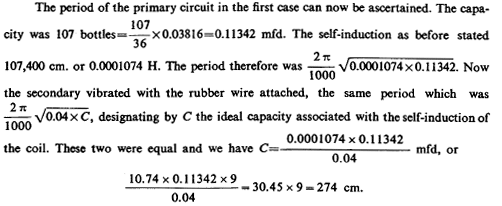




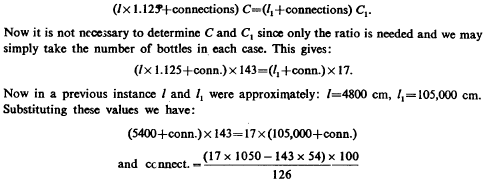
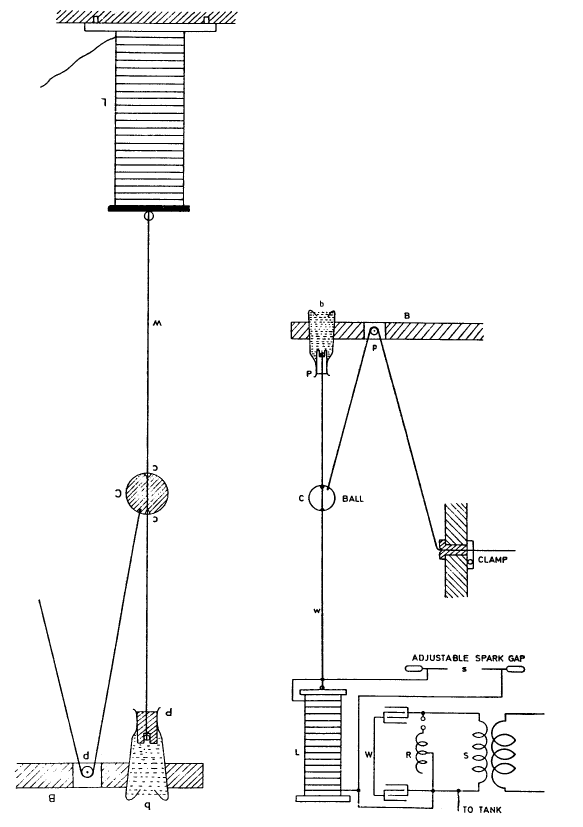
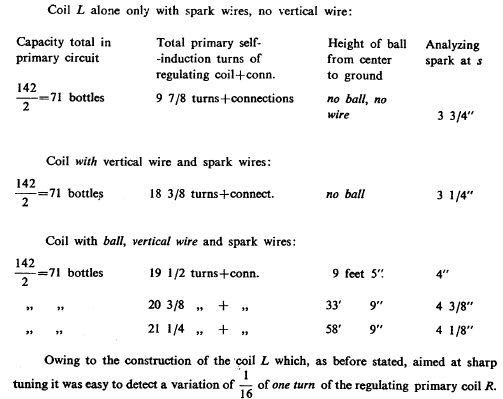














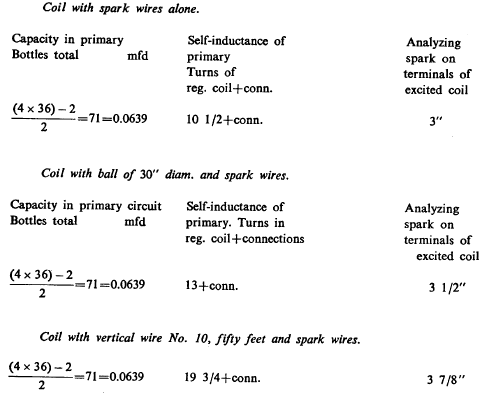

 . Not so small
after all. It was desirable to take some readings with the
self-induction in the primary remaining the same, the capacity only
being varied.
. Not so small
after all. It was desirable to take some readings with the
self-induction in the primary remaining the same, the capacity only
being varied.
